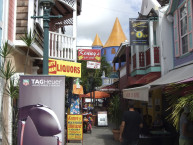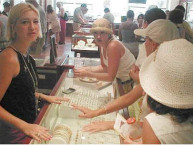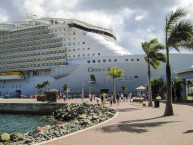Topaz
If you ever wanted to own a topaz, a trip to the islands is the time to buy.  You will find colors of topaz in island jewelry stores that are not available in other regions.
You will find colors of topaz in island jewelry stores that are not available in other regions.
The origin of the word “topaz” is not clear. Some people derive it from the Sanskrit word ‘tapas’= fire. The Romans associated Topaz with Jupiter, the god of the sun.
The most rare of the topaz group will be the family of Imperial Topaz. This includes the colors of pink, salmon, sherry red, champagne, and peach. These colors are very rare. In fact, there is only one mine in the world producing pink topaz and it is expected to last only through the end of this century so the time to buy an Imperial Pink Topaz is now.
Facetted Topaz should be eye clean. Usually facetted Topazes have a perfect brilliancy and luster when they are cut into the right proportions.
In some parts of the world the term Imperial Topaz is applied to different topaz colors However, since this stone originates in South America and is sold most often in the Caribbean islands, the proper color designation for Imperial Topaz is correctly set by the Brazilian gemstone industry. As such, the colors of pink, salmon, champagne, peach, and sherry red, are all considered to be Imperial Topaz by members of the Caribbean Gemological Institute.
Brazil, the region of Ouro Preto in the south of Minas Gerais, produces the finest cognac colors. Topaz from Sri Lanka, Pakistan and Russia is colorless or an odd gray-brown. Colorless rough can be irradiated to produce blue stones
Brazils leading position as a Topaz source in incontestable. Even when grouped together, the Urals, Sri Lanka, the United States, Myanmar, and Pakistan cannot compete with the classic pegmatite source Ouro Preto in the gemstone-rich state of Minas Gerais, which is home to most of the top-quality and select topazes under its roof of weathered rock. Together with aquamarines, topazes are excavated either from their primary deposits or slightly downstream from the valley floors. Their extreme rarity is explained by flourine, which is necessary for their existence and is one of those highly volatile components accumulated in the pegmatitic residual molten masses from which results the chemical compound Al2 SiO4 (F,OH)2 of topaz. Since the residual molten masses do not travel far from their source- such as beryllium, boron, flourine and lithium, which are decisive for the creation of beryl, topaz and tourmaline- their combinations are almost exclusively in pegmatites.
 Blue topaz is one of the most popular gemstones due to its fine array of color and inexpensive price. These stones are colored by several processes which have made them very abundant and affordable.
Blue topaz is one of the most popular gemstones due to its fine array of color and inexpensive price. These stones are colored by several processes which have made them very abundant and affordable.
Topaz should be generally free from inclusions and should be all well cut and proportioned. Colors should be even and uniform with no banding or zoning. Light blue colors will be very affordable. Fine Imperial Pink Topaz and other Im perial Topaz colors can be quite expensive due to their rarity.
perial Topaz colors can be quite expensive due to their rarity.
One important note about Imperial Topaz. In some Imperial Topaz colors, such as sherry red, pink, and salmon, it is quite difficult to find matching stones of any size that perfectly match for color tone and saturation.
If you find a set of well matched earrings set with Imperial Topaz colors you have made a rare find. BUY THEM. You will most likely NOT see them again for any amount of money.
 Caribbean Topaz: This is showing up more and more in the Islands. Please be aware that this is a treated stone. It is a Topaz but it has a thin vapor coating over it which gives it its unusual color sheen. Over time this coating will abrade off, and it won’t look all that pretty anymore. If you are going to have a ring sized or have this stone set make sure your jeweler is aware of this stones treatment. Please also note that the price on this item should be extremly low. This is NOT precious topaz. It’s a low cost item to buy just for the fun of it. It’s a nice look, just not fine jewelry.
Caribbean Topaz: This is showing up more and more in the Islands. Please be aware that this is a treated stone. It is a Topaz but it has a thin vapor coating over it which gives it its unusual color sheen. Over time this coating will abrade off, and it won’t look all that pretty anymore. If you are going to have a ring sized or have this stone set make sure your jeweler is aware of this stones treatment. Please also note that the price on this item should be extremly low. This is NOT precious topaz. It’s a low cost item to buy just for the fun of it. It’s a nice look, just not fine jewelry.
The lore, magic and romance of topaz goes back many thousands of years. It holds the distinction of being the gemstone with the widest range of curative powers.
Ancient Egyptians believed the golden glow of the Topaz symbolized Ra, the Sun God who was the giver of Life.
The Greeks felt it gave them strength. In addition, it supposedly cooled tempers, restored sanity, cured asthma, relieved insomnia and even warded off sudden death.
Topaz is said to make its wearer invisible in time of emergency. It proved the loyalty of associates by changing color in the presence of poison.
During the Middle Ages, religious faith and a belief in the curative properties of gems came to exist side by side. With Topaz, there are several instances of this. For example, the stone was recommended by St. Hildegard as a cure for weak vision. She suggested that the Topaz be placed in a glass of wine and left for three days and three nights. Before going to sleep each evening, the patient was to rub his eyes with the wine-moistened stone so that the moisture lightly touched the eyeballs. The wine could also be drunk for health purposes after the Topaz had been removed for up to five days.
In the 15th century, a certain Topaz was reputed to have caused miraculous cures. The stone responsible for these healings was greatly revered by the faithful because it had belonged to two popes, Clement VI and Gregory II. Subsequently, the Topaz was acquired by a Roman physician who used it to treat those afflicted with the plague. His reported success was said to be due to the fact that the people placed exceptional faith in the healing powers of the papal stone, and it was this faith that did, in fact, hasten their recovery.



